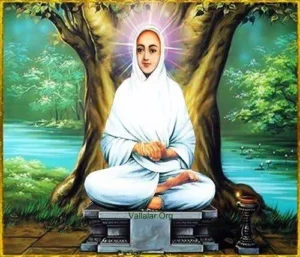 Arutprakasa Vallalār Chidambaram Ramalingam (5 October 1823 – 30 January 1874 [Attained Immortality]), whose pre-monastic name was Rāmalingam, is commonly known in India and across the world as Vallalār. He was one of the most famous Tamil Saints and also one of the greatest Tamil poets of the 19th century and belongs to a line of Tamil saints known as “gnana siddhars” (gnana means higher wisdom).
Arutprakasa Vallalār Chidambaram Ramalingam (5 October 1823 – 30 January 1874 [Attained Immortality]), whose pre-monastic name was Rāmalingam, is commonly known in India and across the world as Vallalār. He was one of the most famous Tamil Saints and also one of the greatest Tamil poets of the 19th century and belongs to a line of Tamil saints known as “gnana siddhars” (gnana means higher wisdom).
Overview
Swami Ramalingam, popularly known as Vallalar, was one of the most notable saints on the Indian sub-continent during the 19th century. He was born on October 5, 1823, in Marudur near Chidambaram into a Hindu Saivite family, the fifth child and last son of his father Ramayya Pillai and mother Chinnammayyar. It is said she had borne him in her womb after she received Vibhuti, the sacred ash of blessings from an unknown guest of honor, a Siva Yogi who blessed her with a son like himself. Vallalar left the world on January 30, 1874 at age 51. When he was only six months old his father died and Ramalinga was brought up under the auspices and tutelage of his elder brother, who, it has been said, had a good working knowledge of things religious.
At the age of 27, he was married to one Danammal. Marital life did not distract him from his religious duty. As an ardent follower of bhakti (the practice of devotional worship) he was a relentless critic of practice based on birth, class, status or privilege. He had no regard for the ‘Puranas’, ‘Vadas’, and the ‘Agamas’. He worshiped God as Light (Jyothi) and was a man of utmost love and compassion for all living creatures. It is said that he would weep at the sight of even a withering crop. He firmly believed in anna dana, the free offering of food to the needy.
Swami Ramalingam as Light Body
It can be seen from the history of his life that in his later years his physical body had become tenuous and translucent. Disciples have recorded that it cast no distinct shadow. It is said that several attempts were made to photograph him, but since light passed through his body no clear image could be obtained. What could be seen were only his clothing and a very misty vision of his face and limbs, and from such a translucent body made so by pure living, dematerialization was but a few steps away.
Swami Ramalingam (Vallalar) says, “Life of eternal bliss is union with God. Those who have achieved this will have transmuted this impure carnal body into a pure golden body and again have the pure body transformed into super sensible, spiritual body”.
Swami Ramalingam’s approach to spiritual life
Spirituality that secluded itself from the common people had no meaning for Swami Ramalingam. His God-consciousness was based on love and compassion. As already seen, he was never at peace when people went without food. What was the meaning of kindness and love if one did not satisfy the hunger of a fellow human being? Moreover, food was the basic need of the body and body was the seat of the soul. Without taking care of the body how could anyone take care of the soul that dwelt in the body? Thus the very basis of spirituality was, according to Swami Ramalingam, the removal of hunger, since removal of hunger mean renovation of the living temple of God, the body.
Swami Ramalingam’s dematerialization
The saint told his disciples that he was in the last days of his physical existence and that he would soon pass into the astral world. He then secluded himself in final preparation.
The news that the saint had locked himself up in a room became known. There was much excitement because the saint had earlier been talking about the possibility of the living dissolution of his physical body. Many people believed him and now they knew the final days had come.
Three months after he locked the door to his room, the news eventually reached the government at Madras. Some officials came to investigate. They ordered the door to be opened. To the great wonder and amazement of all that stood around, they found no one inside the room. A thorough inspection of the whole building was made and nothing suspicious could be found. The officials questioned the disciples and found them to be very simple and innocent people. Now it was clear that, as proclaimed, the saint had achieved the unachievable: without discarding his physical body, he had dematerialized.
The life and writings of Saint Ramalingam (Vallalar) have evidence enough to support dematerialization. They make it clear to us that the swami had been preparing all his life for this final achievement. He had been telling his followers that he would pass into eternal life, not by shedding his physical body, but by changing it into a subtle, invisible, deathless body. There are frequent references in his poems first to the hope and then to the certainty of his union with God by means of acquiring a wonderful, celestial body that would be beyond death or destruction.
Lord, take this body of mine and my spirit in exchange for your body and your spirit to enable this very body of flesh to become a body of light… transmuting” this body of skin and bones, I shine with a golden form you have given me a form perpetual which nothing can destroy… grace, knowledge, love and an indestructible body these have been your gifts to me.

Download Gnanasarikai – Wisdom as Service, by Swami Ramalingham (Vallalar) translation to English
![]()

